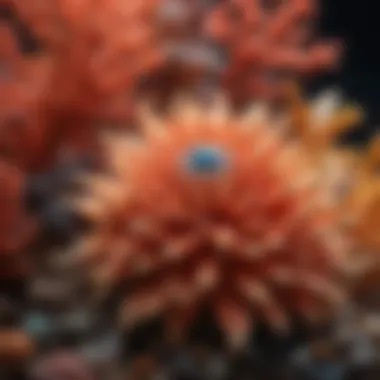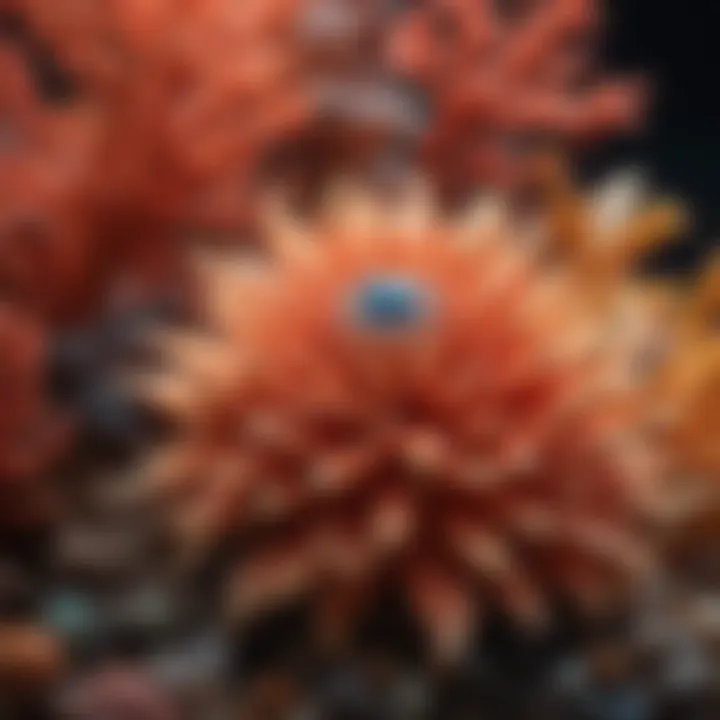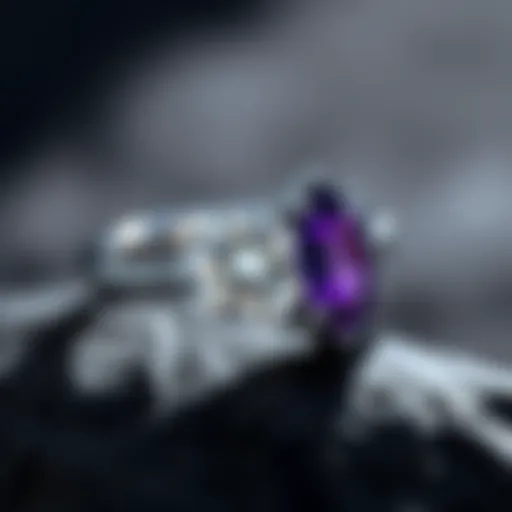Exploring Gemstone Coral: Characteristics & Significance


Intro
Gemstone coral is a unique material that mesmerizes many with its intricate patterns and rich colors. Though often overlooked in the realm of gemstones, it holds a significant place in both geological and cultural contexts. The aim of this article is to delve into the characteristics, cultural significance, and practical insights associated with gemstone coral. By exploring its definitions, historical roots, and practical advice on care and maintenance, we hope to provide a comprehensive understanding of this fascinating gem.
Gemstone Overview
Definition of Gemstones
Gemstones are mineral crystals or organic materials that are cut and polished for use in jewelry and decorative items. They are valued for their beauty, rarity, and durability. Gemstone coral, classified as an organic gemstone, forms from the skeletons of marine coral, which over time becomes fossilized, resulting in beautiful colors and patterns. This unique process distinguishes it from traditional mineral gemstones.
Classification of Gemstones
Gemstones can be broadly classified into three categories: precious, semi-precious, and organic gemstones. Coral falls under the organic category, alongside others like amber and jet. Within this classification, gemstone coral can also be further differentiated based on its color, origin, and specific type of coral species.
"Gemstone coral is not just a treasure of the ocean but a record of time and nature's artistry."
Historical Significance
Origins of Gemstone Use
The use of coral as a gemstone dates back thousands of years. Ancient civilizations valued it not only for its aesthetic appeal but also for its believed protective properties. Archaeological findings indicate that coral was utilized in jewelry and ornamentation across various cultures, establishing its enduring popularity.
Cultural Insights: Gemstones in Ancient Civilizations
In ancient Rome and Greece, coral was widely used in jewelry and amulets. It was believed to ward off evil and protect against harm. Similarly, in other cultures, such as in Africa and Asia, coral held spiritual significance, often incorporated into rituals and traditional practices. The color red was associated with life force and vitality. In contemporary society, these cultural significances continue to influence gemstone coral's appeal, attracting both collectors and enthusiasts.
By understanding the foundations of gemstone coral, its characteristics, and cultural ties, readers can appreciate its value and role in the gemological landscape. The exploration does not stop here. Next, we will dive into the unique characteristics and care tips for this remarkable material.
Preface to Gemstone Coral
Gemstone coral is a natural creation that has attracted attention due to its unique aesthetic and cultural significance in various societies around the world. The importance of this topic lies not only in its beauty but also in its multifaceted relationship with humanity and nature. Understanding gemstone coral offers insights into how natural resources can influence art, jewelry design, and economic practices. This article will delve deep into the characteristics of gemstone coral, its origins, and ongoing relevance.
While many view coral merely as a decorative element, it represents much more. Its enchanting appearance and vibrant colors have made it a sought-after material in jewelry. However, many people may not realize the intricate balance between harvesting coral and protecting marine ecosystems. Thus, discussing gemstone coral invites consideration of sustainability, cultural appreciation, and market trends.
Definition and Origins
Gemstone coral, often referred to simply as coral, derives from marine animals known as corals. Specifically, gemstone varieties are sourced from the skeletons of these organisms, primarily from the Corallium genus. The process of transforming coral into a gemstone entails careful harvesting and processing of the skeletal remains, which possess unique hues such as red, pink, and black.
Coral has a storied history, with its use tracing back thousands of years. Ancient civilizations used it for various purposes—ranging from jewelry to protective amulets believed to ward off negative energies. The Mediterranean Sea is notably famous for producing fine red coral. Traditional methods of harvesting have remained prevalent in some regions, continuing to connect modern jewelry with ancestral practices.
Scientific Classification
In the realm of biological and geological sciences, coral is classified as a member of the phylum Cnidaria, which includes organisms forming colonies through polyp reproduction. The gemstone types—such as red, pink, and black coral—each belong to specific species that vary in traits such as strength, color intensity, and habitat. For instance, red coral, scientifically referred to as Corallium rubrum, is particularly prized for its vivid red color and durability. It grows primarily in deep waters, making it less accessible and therefore more valuable.
Investigation into the scientific foundation of gemstone coral reveals essential details that enhance appreciation. The environmental conditions that foster coral growth, including water temperature, depth, and light, directly affect not only their physical traits but also their harvesting practices. As interest in coral gemstones grows, understanding their classification becomes paramount for both collectors and jewelers alike, ensuring responsible sourcing and appreciation of such a remarkable natural phenomenon.
Formation of Coral as a Gemstone
The formation of coral as a gemstone encompasses both biological processes and geological factors. Understanding these elements is essential for appreciating the value and uniqueness of coral. Coral gemstones are derived from marine organisms, primarily from the genus Corallium. Their intricate structures and natural hues contribute to their allure in jewelry and decorative pieces. This section discusses the biological mechanisms involved in coral formation and the geological conditions that enhance its characteristics.
Biological Processes
Coral begins its journey as tiny polyps, small cnidarian organisms that attach to a solid surface on the ocean floor. These polyps excrete a calcium carbonate skeleton, which over time accumulates and builds up into larger structures known as coral reefs. The growth of coral is a complex process that depends heavily on symbiotic relationships. Coral polyps host zooxanthellae, microscopic algae that participate in photosynthesis. These algae provide energy to the coral while benefiting from the polyp’s waste products. The colors we associate with coral, such as red, pink, and white, develop from both the polyps and the minerals in their environment.


Additionally, the growth rate of coral varies significantly by species and environmental conditions. For gemstone-quality coral, the most desirable specimens are slower-growing. This slow growth allows for denser, more intricately patterned formations, which hold greater appeal for jewelry making and collecting.
Geological Factors
The geological environment where coral grows significantly impacts its qualities as a gemstone. Corals thrive in warmer, shallow waters, primarily in tropical and subtropical regions. A key geological factor is the type of sediment and water chemistry present. Coral reefs typically prefer calcium-rich waters. This preference leads to a higher quality calcium carbonate skeleton, making the coral denser and more durable.
Currents also play a critical role in coral growth. Strong ocean currents can limit sedimentation, allowing clearer waters that let sunlight penetrate deeper. This light supports the vital algae and promotes healthy coral growth. Conversely, excessive sediment from coastal activities can smother corals, affecting their health and formative potential.
"The delicate balance of biological and geological factors underscores the uniqueness of gemstone coral, making each piece a reflection of its specific environment."
In summary, the formation of coral as a gemstone is determined by a combination of biological processes that create the coral itself and the geological conditions that enhance its aesthetic qualities. The interplay between these factors influences the appearance, durability, and overall desirability of coral in the gemstone market. Understanding these elements is crucial for gemstone enthusiasts and collectors alike, as they highlight the natural beauty and intricacy inherent in every piece of gemstone coral.
Types of Gemstone Coral
Understanding the different types of gemstone coral is essential for collectors and jewelry designers. Each type has unique characteristics that contribute to its aesthetic appeal and market value. The variations in color, hardness, and cultural significance can influence purchasing decisions greatly. Moreover, knowing the distinctions among types can enhance appreciation for coral as a natural, artistic medium in jewelry.
Red Coral
Red coral, often sought after for its vibrant hue, is one of the most renowned forms of gemstone coral. This coral is primarily found in the Mediterranean Sea, particularly along the coasts of Italy and France. The rich red color comes from the calcium carbonate that forms the coral structure, combined with the living polyp's pigments. Red coral is valued not only for its beauty but also for its cultural significance in various societies. For instance, it has been used for centuries in jewelry making and is often associated with protection and prosperity.
When considering red coral, factors such as color saturation, texture, and resin treatment should be taken into account. High-quality specimens exhibit a rich, deep red, while those that are pale or overly processed may not hold the same value. Collectors often look for pieces that retain their natural imperfections, as this can enhance their authenticity and appeal.
Black Coral
Black coral is distinguished by its dark, almost ebony appearance. This type of coral is predominantly found in tropical waters, particularly in the Pacific Ocean. It is harvested mainly from deep-sea environments and can often be mistaken for other black materials like jet or obsidian.
Black coral's cultivation and sustainability are crucial issues. Its harvesting has led to concerns about overfishing and habitat destruction. Therefore, ensuring sourced products are responsibly obtained is essential for collectors and consumers alike. Black coral is not only used in jewelry but also in carving and decorative arts, where its unique hue can be showcased effectively.
Due to its rarity and the environmental concerns surrounding it, black coral can command high prices in the market. It can also serve profound meanings in various cultures, often symbolizing strength and resilience.
Pink Coral
Pink coral is cherished for its delicate, blush-colored hues. Found mostly in the shallow waters of the Mediterranean and around Japan, this coral varies from soft pink to deeper, almost red shades. Pink coral has gained popularity in architectural applications and delicate jewelry designs.
Like red coral, pink coral is often associated with feelings of love and compassion. Many cultures utilize it in decorative arts and spiritual rituals. Due to its charm and the increasing demand for pink shades in fashion, its market value has risen considerably over the years.
When evaluating pink coral, one should consider not just the color, but also its clarity and how it has been processed. Natural pink coral should exhibit a smooth finish and a consistent color throughout.
Cultural Significance of Coral
Gemstone coral holds a place of great importance in various cultures around the world. It is not just a beautiful material for decoration; it has historical meanings and symbolic values. Understanding these cultural dimensions enriches our appreciation of gemstone coral.
Historical Context
Coral’s use dates back thousands of years. Ancient civilizations, such as the Egyptians, recognized its beauty and attributed mystical properties to it. They often buried coral with their dead, believing it would provide protection in the afterlife. Similarly, in Roman times, coral was favored for jewelry as a status symbol. Artisans finely crafted it into intricate designs, making it a sought-after material among the wealthy.
Many indigenous tribes across the globe also regard coral with reverence. For instance, the Native Hawaiians believed coral was the embodiment of ancestral spirits, thus using it in ceremonial practices. In many cultures, coral has been prominently featured in artifacts, encompassing a wide range of applications from jewelry to tools. This historical context highlights the enduring allure of coral.
Symbolism in Various Cultures
Coral holds distinct meanings in different cultures. In Mediterranean societies, red coral, in particular, symbolizes life and fertility. It is often worn as an amulet to ward off evil or misfortune. The vibrant red color is seen as a representation of vitality, making it popular in jewelry that adorns weddings and celebrations.
In Asian cultures, particularly among Chinese communities, coral denotes good luck and prosperity. Its placement in homes or wearing it is believed to enhance positive energy. While in Japanese culture, coral is valued for its connection to the ocean, serving as a reminder of nature's bounty.
"The significance of gemstone coral transcends aesthetics; it embodies deep historical and cultural narratives that enrich our understanding of human interaction with nature."


Beyond these symbols, coral’s role in various folklore further emphasizes its cultural relevance. It often appears in myths and stories that reflect human concerns with nature, beauty, and continuity. This rich symbolic tapestry underscores coral's multifaceted role in societies.
In summary, the cultural significance of gemstone coral is vast, reflecting its historical use and symbolic meanings across different cultures. Recognizing these aspects not only enhances the value of coral as a gemstone but also connects individuals to the stories and traditions of past generations.
Metaphysical Properties of Coral
The metaphysical properties of gemstone coral attract significant interest among collectors and enthusiasts. Many people believe in the healing powers of gemstones, and coral is no exception. Used for centuries in various cultures, coral is seen as a stone that offers both physical and emotional benefits. Understanding these properties can enhance one's appreciation for coral beyond its aesthetic appeal.
Healing Attributes
Coral is often associated with various healing attributes. Practitioners of crystal healing commonly use it to promote physical well-being. It is thought to strengthen the immune system and stimulate tissue regeneration. Some believe that coral can help with issues related to circulation or even assist in the healing of bones and teeth. These benefits make coral a popular choice among those seeking alternative health approaches.
The vibrant red or pink hues of coral are said to resonate with the root and heart chakras, promoting grounding and emotional stability. Many practitioners recommend placing coral near the body's energy centers to achieve the maximum benefit. This practice aligns with beliefs in the direct influence of gemstones on personal energy and vitality. If you aim to enhance your well-being, incorporating coral into your life might be worth considering.
"Coral's connection to healing is both ancient and profound, making it a valuable addition to any collection."
Emotional Benefits
Not only is coral recognized for its healing properties, but it also serves emotional support. Many believe that gemstone coral fosters love and compassion. It is thought to assist individuals in overcoming emotional turmoil and building harmonious relationships.
The soothing colors of coral can create a calming atmosphere. This is particularly helpful for people who experience anxiety or emotional disturbances. Wearing coral jewelry or surrounding oneself with coral can create a sense of comfort and security. Jewelers often incorporate it into pieces designed with these metaphysical properties in mind, appealing to those who prioritize emotional well-being.
Moreover, coral is seen as a stone of communication. It is believed to promote clarity in both speech and thought, allowing individuals to express their feelings more effectively. This aspect is especially revered in social or intimate situations where open communication is vital.
Ultimately, the emotional benefits attributed to gemstone coral contribute to its allure as a meaningful accessory. As collectors and enthusiasts explore their choices, understanding these attributes can inform their selections.
Integrating coral into daily life can be a conscious choice for enhancing both physical and emotional health.
Gemstone Coral in Jewelry
Gemstone coral holds a unique position in jewelry making, reflecting both natural beauty and cultural significance. Its vibrant colors and organic patterns make it a favored choice among designers and collectors alike. Coral jewelry is not merely ornamental; it represents history, tradition, and a connection to the ocean. Understanding its importance helps enthusiasts appreciate the nuances of this exquisite material.
Popular Designs and Settings
When it comes to popular designs incorporating gemstone coral, the options are diverse. Jewelry pieces often feature coral in the following ways:
- Necklaces with Coral Beads: Stringing coral beads creates striking necklaces. The variations in color and texture can complement many outfits, making them versatile.
- Coral Rings: Rings can be designed with a single coral cabochon or multiple pieces set in intricate patterns. This form is often a center of interest in the jewelry collection.
- Earrings with Coral Accents: Coral can be used as pendants or charms in earrings, adding a playful touch to one's ensemble.
- Bracelets: Coral bracelets, whether in strands or as accents on a cuff, embody elegance while being easy to wear.
Each design reflects the natural properties of coral, enhancing its appeal. The settings can vary from simple gold or silver frames to elaborate designs that highlight the coral's organic forms.
Care and Maintenance of Coral Jewelry
Taking care of coral jewelry is crucial to maintaining its beauty and durability. Here are key points to consider:
- Avoid Harsh Chemicals: Coral is sensitive to chemicals found in many household products. Keep it away from perfumes, hairsprays, and cleaners.
- Clean with Soft Cloth: Cleaning should be done gently with a soft, damp cloth to remove dirt and oils that accumulate over time.
- Store Properly: When not in use, store coral jewelry in a soft pouch or jewelry box lined with fabric to prevent scratches.
- Limit Exposure to Water: While some coral jewelry can tolerate occasional water exposure, it's best to limit this, especially with saltwater and chlorine.
- Regular Inspections: Periodically check for loose settings and deterioration in quality. This ensures that the jewelry remains in good condition for years to come.
By following these care tips, wearers can ensure that their gemstone coral jewelry remains beautiful and vibrant, celebrating its uniqueness and the story it tells.
"Each piece of coral jewelry carries with it a piece of history and a connection to the natural world, making it a treasure worth preserving."
Understanding gemstone coral in jewelry not only enhances one’s collection but also fosters a deeper appreciation for its natural origins and the craftsmanship involved.
Purchasing Gemstone Coral


Purchasing gemstone coral is an important aspect for both enthusiasts and collectors. It involves understanding the unique characteristics and qualities that differentiate authentic coral from imitations or inferior products. With a rising demand in the market, the value and quality of gemstone coral can vary significantly. Therefore, knowing the essential elements to consider when buying coral is crucial.
When considering a purchase, buyers should pay close attention to the origin, color, and condition of the coral. Authentic gemstone coral originates from specific species and environments. For example, red coral is primarily found in the Mediterranean Sea, while black coral is more common in tropical waters. Each type has its own value and significance, and understanding these differences can help in making a more informed choice.
Moreover, the color intensity and evenness of the coral are significant indicators of quality. Higher quality coral exhibits vibrant, deep colors without inconsistencies. Additionally, buyers should check for any signs of damage, such as cracks or discoloration, which can affect both aesthetic and monetary value.
"The allure of gemstone coral lies not only in its beauty but also in its intricate history and natural formation."
Identifying Quality Coral
Identifying quality coral is integral to ensuring a worthwhile investment. First, buyers should look for tangible markers of authenticity. Genuine coral typically has a smooth texture and a natural sheen. Moreover, to assess its quality, one can examine the coral under proper lighting. Authentic coral will often display variations and subtleties in its color, while synthetic or dyed counterparts may lack depth and appear overly uniform.
Another important tip is to familiarize oneself with various inclusions found in coral. Natural coral may contain small imperfections or variations that are part of its charm. In contrast, overly polished or perfectly uniform coral often signals that it might not be genuine.
Reputable Sources for Purchase
Finding reputable sources for purchasing gemstone coral is essential. Buyers should look for established jewelers or specialized shops that focus on coral and marine-related gemstones. Online platforms can also offer a range of options but require careful scrutiny. Websites such as en.wikipedia.org and britannica.com can provide valuable insights into the sellers and the market trends.
It is advisable to check customer reviews and ratings to gauge a seller's reliability. Furthermore, asking vendors for certification or provenance documentation is recommended. Such information can confirm the authenticity and origin of the coral, ensuring that the purchase is both legitimate and ethical.
Environmental Considerations
Gemstone coral is an exquisite and unique material, but its value comes with pressing environmental issues. Understanding the environmental challenges related to coral harvesting is essential for enthusiasts and the jewelry market alike. Coral reefs provide critical ecosystem services, including habitat for diverse marine life and coastal protection against storms. However, due to overfishing, pollution, and climate change, these ecosystems are under threat. The importance of sustainable practices in the gemstone coral industry cannot be overstated, as it directly impacts the survival of coral species and the overall health of marine environments.
Sustainability Issues
The sustainability of gemstone coral is a growing concern. Harvesting practices for coral have often been unsustainable, leading to significant declines in coral populations. This creates a ripple effect, impacting not just the species themselves but also the myriad of organisms that rely on coral reefs for survival. Overexploitation and illegal fishing practices complicate the situation further. Regulations surrounding the collection of coral must be enforced to preserve these precious resources for future generations.
Factors such as pollution from coastal development and agricultural runoff exacerbate these sustainability issues. Consequently, the health of coral reefs diminishes, lowering their capacity to regenerate. It is crucial to find a balance between economic interests and environmental preservation through responsible sourcing and supporting sustainable applications in jewelry design.
Conservation Efforts
Numerous organizations and initiatives focus on the conservation of coral reefs. These efforts aim not only to protect coral populations but also to restore and rehabilitate damaged ecosystems. Marine protected areas (MPAs) have been established in various locations, restricting access and allowing coral to recover. Local communities are also engaged in conservation actions, learning sustainable methods to manage coral resources.
Education plays a significant role in these conservation efforts. Raising awareness about the importance of coral ecosystems among consumers can drive demand for ethically sourced gemstone coral. By choosing coral products that adhere to environmental standards, consumers can influence market practices positively.
"Credible conservation efforts hinge on consumer awareness, showcasing the impact of informed choices."
The End: The Enduring Appeal of Gemstone Coral
Gemstone coral, with its unique beauty and diverse cultural significance, holds a special place in the world of gemstones. The exploration of this material has revealed not just its aesthetic qualities but also its historical and ecological contexts. Understanding the characteristics of gemstone coral allows enthusiasts and collectors to appreciate its value beyond mere physical appearance.
Importance of Gemstone Coral
One primary reason for the enduring appeal of gemstone coral lies in its distinct colors and forms. The variations among red, black, and pink coral create a wide palette for designers and collectors. Artists often choose coral for its capacity to add depth and richness to jewelry pieces. Additionally, the ability of coral to be carved into detailed shapes further enhances its desirability. All of these attributes work together to make coral an impressive choice in jewelry making.
Moreover, the cultural significance of coral cannot be emphasized enough. Throughout history, different cultures have attributed various meanings to this precious material. From ancient beliefs to modern practices, coral has been seen as a protector and a bringer of good fortune. This perception adds an element of mystique that attracts many to coral jewelry.
Practical Considerations
When it comes to the practical aspects, preserving the quality and vibrancy of gemstone coral is essential. Coral jewelry requires specific care to maintain its luster and prevent damage. Owners are encouraged to follow particular cleaning protocols and store pieces in a preferable environment. Doing so ensures the longevity of each item, making it a worthwhile investment.
Additionally, being informed about sustainable sourcing is vital. The increasing awareness of environmental challenges has led many enthusiasts to seek ethically sourced coral. Supporting conservation efforts enriches ownership, providing a connection to the broader ecological context of this gemstone.
Coral has become a symbol that represents not only beauty but also environmental responsibility.
Synthesis of Information
The exploration of gemstone coral presents a narrative intricately woven with aesthetic appeal, cultural depth, and ecological responsibility. As readers absorb these insights, they gain a thorough understanding of how gemstone coral stands out in the vast world of gemstones. Its unique characteristics make it a coveted material in various applications. Concurrently, the rich tapestry of cultural significance ensures that coral isn’t just a gemstone; it is a link to history and tradition.
In summary, the study of gemstone coral encourages collectors, designers, and enthusiasts alike to appreciate the lasting allure of this remarkable material. Understanding its diverse facets may seem intricate but is ultimately rewarding, providing a deeper engagement with the world of gemstones.



